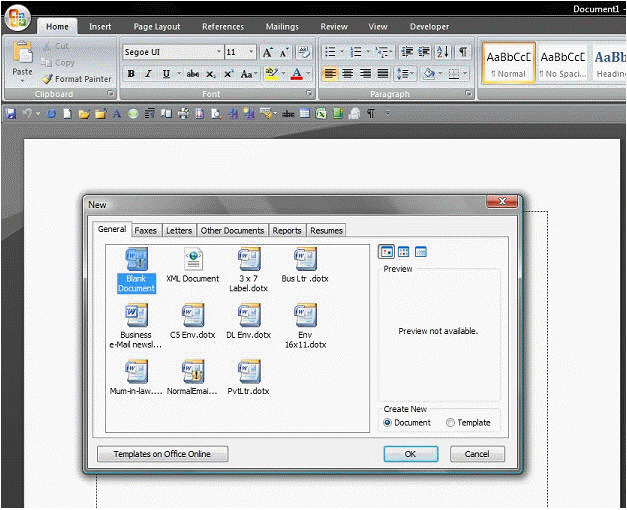Registry Tweaks for Word 2007
Article contributed by Terry Farrell
WARNING: changing the Registry incorrectly can have serious consequences. So please take extra care to make the correct changes. If you are unfamiliar with editing the Registry, please see The Registry Editor and Backing Up the Registry at the end of this article.
Deleting a document from the MRU file list
Single, multiple or all entries on the MRU (most recently used) file list seen when you click on the Office Button are stored in the Registry. To remove a document from the list, run regedit (see end) and drill down to the following key:
HKEY_CURRENT_USER\Software\Microsoft\Office\12.0\Word\File MRU
Delete the document that you don’t want in the MRU by selecting it and pressing DELETE. (Don’t be concerned about the Item numbering as the Registry will renumber these when it closes.)
Open Word and the document(s) will have been removed from the MRU.
If you believe that you will be doing this regularly, before exiting the Registry Editor, add the key to the Registry Favorite list. With MRU selected, click on Favorites, Add to Favorites...

Removing unwanted templates from the File, New dialog
In Word versions prior to Word 2003, File | New opened the dialog shown below. In Word 2003, the default was to open the Task Pane, but the traditional File, New dialog was still available and could be added to a Toolbar. Similarly, the dialog can be added to the QAT (see below) in Word 2007.

Unfortunately, the dialog was full of tabs containing Microsoft-installed templates that many users did not want. These were fairly simple to remove in previous versions, but in Word 2007, all has changed. The traditional File | New dialog is now three mouse-clicks away under the Office Button | New | My Templates and it is even more difficult to remove those unwanted templates and tabs. The templates are the same as those displayed by Office Button | New | Installed Templates. This Registry tweak will remove any or all unwanted templates from both places.
Add the File, New dialog shortcut to your Quick Access Toolbar (QAT)
Right-click on the QAT and select Customize Quick Access Toolbar...
From the Choose Commands From... drop down list, select All Commands
Scroll down and select the New Document or Template... command.
Click on the Add>> button. (Note that you can move its location in the list to organise the QAT in the order you want it.)
Click on OK to close the dialog. The File, New command is now on your QAT.
Remove unwanted templates
Run regedit (see end) and expand each group until you reach
HKEY_CLASSES_ROOT\Installer\Components\8F622368F04F7B849A7B2021EE668F21
You can select individual keys and rename them to remove individual templates or you can rename the top level key (8F622368F04F7B849A7B2021EE668F21) to remove them all. I usually add the word BAD to the start of the key as in the screenshot example.


The Registry Editor
Opening the Registry Editor: From Start | Run (or Winkey+R), type
regedit
and press Enter. The Registry Editor will open.
In Vista, you can also press Start and type
regedit
and press enter or click OK.

To navigate to a Registry key: such as
HKEY_CURRENT_USER\Software\Microsoft \Office\12.0\Word\File MRU
either double-click HKEY_CURRENT_USER or click on the triangular bullet to the left of the key.
Then do the same for SOFTWARE > Microsoft > OFFICE > 12.0 and WORD drilling down to the FILE MRU key.
Note that when the Registry Editor is closed, it remembers its condition. When it is next opened, you may need to collapse all the keys. Use Control+Home and then double click the top level key to close all beneath.
Backing up the Registry
Export the Registry
Please export a copy of your Registry to a safe place before making changes. Note that Registry changes are instant: there are no Save or Undo options, so once you have pressed DELETE, the item selected is deleted.
Open the Registry Editor:
From Start | Run, (Winkey+R), type in
regedit
and press ENTER. Use File, Export to send a copy of the Registry to a flash memory key or other external storage device. Close the Registry Editor.
System Restore
I also recommend that you use System Restore to create a new restore point immediately before changing the Registry. You are then able to revert to pre-edit condition if the procedure goes wrong by using the Restore point you created (so name it sensibly).

Use Winkey+Break and select System Protection which opens Systems Properties, System Protection tab. Wait whilst the system finds the most recent Restore points, which may take a minute or two. Then click CREATE to open the Create a Restore Point dialog and type in a name. Click OK and wait for the system to create the restore point which may take a minute or two. Close the dialogs.
You now have two ways of recovery if editing the Registry goes wrong.
